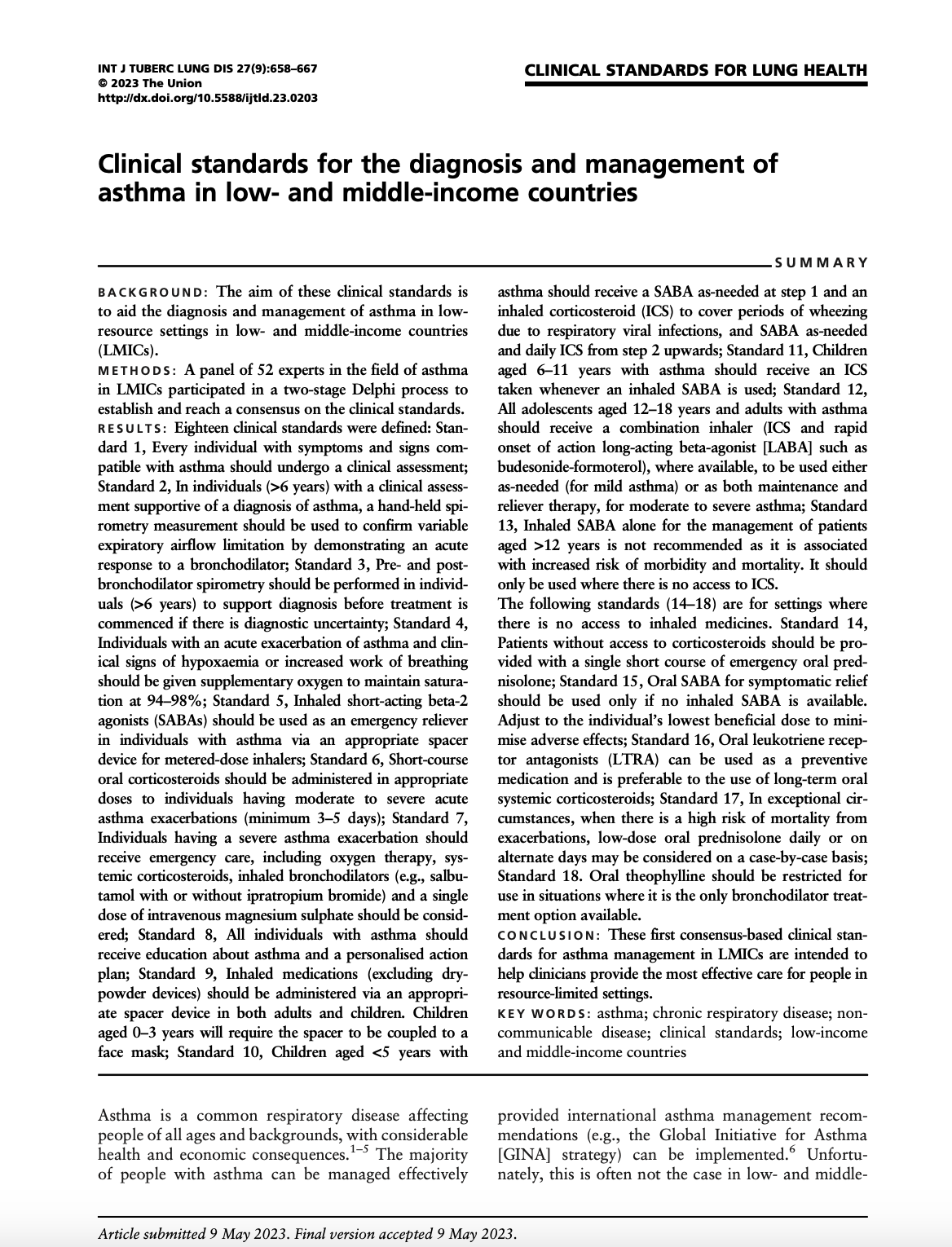NCD Alliance
Pocket guide: Turning HLM4 commitments into action
Guide
27 Nov 2025
The International Journal of Tuberculosis and Lung Disease
01 Sep 2023

BACKGROUND: The aim of these clinical standards is to aid the diagnosis and management of asthma in low-resource settings in low- and middle-income countries (LMICs).
METHODS: A panel of 52 experts in the field of asthma in LMICs participated in a two-stage Delphi process to establish and reach a consensus on the clinical standards.
RESULTS: Eighteen clinical standards were defined: Standard 1, Every individual with symptoms and signs compatible with asthma should undergo a clinical assessment; Standard 2, In individuals (>6 years) with a clinical assessment supportive of a diagnosis of asthma, a hand-held spirometry measurement should be used to confirm variable expiratory airflow limitation by demonstrating an acute response to a bronchodilator; Standard 3, Pre- and post-bronchodilator spirometry should be performed in individuals (>6 years) to support diagnosis before treatment is commenced if there is diagnostic uncertainty; Standard 4, Individuals with an acute exacerbation of asthma and clinical signs of hypoxaemia or increased work of breathing should be given supplementary oxygen to maintain saturation at 94–98%; Standard 5, Inhaled short-acting beta-2 agonists (SABAs) should be used as an emergency reliever in individuals with asthma via an appropriate spacer device for metered-dose inhalers; Standard 6, Short-course oral corticosteroids should be administered in appropriate doses to individuals having moderate to severe acute asthma exacerbations (minimum 3–5 days); Standard 7, Individuals having a severe asthma exacerbation should receive emergency care, including oxygen therapy, systemic corticosteroids, inhaled bronchodilators (e.g., salbutamol with or without ipratropium bromide) and a single dose of intravenous magnesium sulphate should be considered; Standard 8, All individuals with asthma should receive education about asthma and a personalised action plan; Standard 9, Inhaled medications (excluding dry-powder devices) should be administered via an appropriate spacer device in both adults and children. Children aged 0–3 years will require the spacer to be coupled to a face mask; Standard 10, Children aged <5 years with asthma should receive a SABA as-needed at step 1 and an inhaled corticosteroid (ICS) to cover periods of wheezing due to respiratory viral infections, and SABA as-needed and daily ICS from step 2 upwards; Standard 11, Children aged 6–11 years with asthma should receive an ICS taken whenever an inhaled SABA is used; Standard 12, All adolescents aged 12–18 years and adults with asthma should receive a combination inhaler (ICS and rapid onset of action long-acting beta-agonist [LABA] such as budesonide-formoterol), where available, to be used either as-needed (for mild asthma) or as both maintenance and reliever therapy, for moderate to severe asthma; Standard 13, Inhaled SABA alone for the management of patients aged >12 years is not recommended as it is associated with increased risk of morbidity and mortality. It should only be used where there is no access to ICS.
The following standards (14–18) are for settings where there is no access to inhaled medicines. Standard 14, Patients without access to corticosteroids should be provided with a single short course of emergency oral prednisolone; Standard 15, Oral SABA for symptomatic relief should be used only if no inhaled SABA is available. Adjust to the individual’s lowest beneficial dose to minimise adverse effects; Standard 16, Oral leukotriene receptor antagonists (LTRA) can be used as a preventive medication and is preferable to the use of long-term oral systemic corticosteroids; Standard 17, In exceptional circumstances, when there is a high risk of mortality from exacerbations, low-dose oral prednisolone daily or on alternate days may be considered on a case-by-case basis; Standard 18. Oral theophylline should be restricted for use in situations where it is the only bronchodilator treatment option available.
CONCLUSION: These first consensus-based clinical standards for asthma management in LMICs are intended to help clinicians provide the most effective care for people in resource-limited settings.